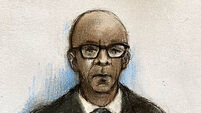Put your best foot forward as you get older

IF you moan and groan as you get up off the chair — and it’s because some part of your body is complaining, well don’t blame ‘old age’.
You would want to be on another planet to have not heard how important it is to continue to move (and groove!) as the years push on, to keep us flexible and physically independent.
The World Health Organisation (WHO) recommends that those of us over 55 should be doing a minimum of 30 minutes of moderate to vigorous physical activity on five or more days of the week — a total of 150 minutes per week.
So what’s moderate to intense activity?
It refers to activities which require us to expend somewhere between three to six times the energy than if we were resting for the same period, says Brian Carson, an exercise physiologist in the physical education and sports sciences department of the University of Limerick.
If you are stepping it out, or hopping around, and meeting those requirements give yourself a good slap on the back. But wait! There is more.
Whatever way you are getting that aerobic activity — which is great for your bones, it’s only sufficient if you are doing some strength training as well, according to the WHO guidelines.
When you stop and think about it, if we have been lucky enough to live over half a century, we should say a big thank you to ‘dem bones’ for getting us so far; we have lived in the same body since we emerged as a squalling baby on Earth.
It makes total sense that after a minimum of five decades and more, there is wear and tear — who could count the number of steps we have taken since those first ones as a toddler?
In fact, we begin to lose muscle mass as early as in our 30s. And here’s the issue: If people are not physically active they can lose as much as 3% to 5% of their muscle mass each decade after age 30.
It’s usually only later we notice it though... like now. With muscles, like your brain, it’s a case of ‘use it or lose it’. On average, people lose about 30% of their muscle strength between ages 50 and 70, and another 30% of what’s left, per decade after that.
But, here’s the good news: it’s never too late to build muscle and that’s why the WHO recommendation is there, as confirmation of that fact.
Studies show that regular strength-training can also increase bone density and reduce the risk of osteoporosis. High-impact weight-bearing exercises help build bones and keep them strong.
But what is high-impact exercise? You may be surprised. You don’t actually have to be pumping iron. Any exercises you do on your feet so that your bones and muscles have to work against gravity to keep you upright, do the trick.
Your bones react to the weight put on them by building themselves up and getting stronger.
Examples of such activity include dancing, hill climbing, jogging and running, tennis, pushing the lawn mower — and stair climbing, so skip that lift every time you go into the office or multi-storey carpark and remind yourself of the good you are doing.
In case you aren’t convinced yet though, here are some other benefits of strength training, outlined by the Mayo Clinic:
Strength training can help you manage or lose weight, and it can increase your metabolism to get you burning more calories.
Strength training may enhance your quality of life and improve your ability to do everyday activities. Building muscle can also contribute to better balance and may reduce your risk of falls. This can help you maintain independence as you age.
Strength training can reduce the signs and symptoms of many chronic conditions, such as arthritis, back pain, obesity, heart disease, depression and diabetes.
Some research suggests that regular strength training and aerobic exercise may help improve thinking and learning skills for older adults.
But let’s leave the last word to Dr Claire Parker from her book Sod 60! which she co-wrote with Dr Muir Gray last year.
“Regular exercise reduces the risk of breast cancer by as much as 25%; of bowel cancer by as much as 45%; of ever developing dementia by as much as 30%; of the risk of ever getting a stroke by 30% and of heart disease by over 40%,” she says.
And it’s not just her word. She’s quoting a report published by the Academy of Medical Royal Colleges in 2015.
If you could get a prescription to prevent all those risks happening to you, as you age, wouldn’t you be first in the queue?
Well, now you know; it’s in your own hands — and your whole body.








